
* In the early 1960s, the Red Air Force acquired a new four-engine turboprop cargolift aircraft, the "Antonov An-12", which was built in good numbers and has provided excellent service for operators in dozens of countries. The An-12 remains in use in the 21st century. This document provides a history and description of the An-12, its "An-8" predecessor, its "An-10" civil airliner sibling, and the "An-70" follow-on.
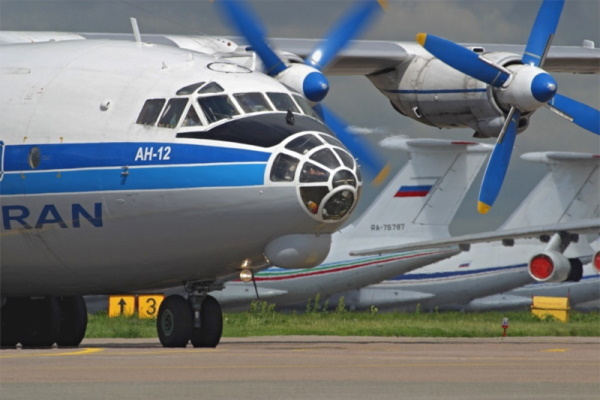
* In the early 1950s, the Soviet aircraft design bureau (OKB in its Russian acronym) run by Oleg Antonov began work on a military cargolifter that would feature the new TV-2 turboprop engine, then being developed by the Kuznetsov engine OKB. Full development of the aircraft was authorized in 1953, with the prototype of the "An-8" performing its initial flight on 11 February 1956, with Captain Yakov I. Vernikov at the controls. The An-8 was revealed to the public on 18 August during the Tushino / Moscow Aviation Day display. The first production An-8 was rolled out in August 1958 from State Factory Number 84 in Tashkent, now the capital of the independent nation of Uzbekistan, with the type going into service in 1959.
The An-8 was a tidy-looking aircraft in the class of the later Franco-German Transall C-160 transport, and of similar configuration. It had a high-mounted wing, a boxy fuselage, main gear in fairings alongside the fuselage to leave internal space for cargo, and a high tail with rear doors.
Although the prototype had been powered by TV-2T engines, the TV-2T ran into developmental difficulties, and so production machines were powered by Ivchenko AI-20D turboprops, providing 3,865 kW (5,180 EHP) maximum each and driving four-bladed reversible propellers. The AI-20D could only deliver about 85% of the power of the hoped-for TV-2T engines, and so the An-8 was dogged by lack of power. There had also been consideration of turbojet propulsion -- the full-scale mockup of the An-8 put together in the course of development had featured a turboprop on the left wing and a jet engine on the right -- but no doubt turbojets couldn't meet the range spec.
The An-8 was designed, like most Soviet cargolifters, for rough-field operation. The nose gear had twin wheels, while each of the main gear assemblies had four wheels in a 2x2 bogey arrangement. All gear assemblies retracted backwards, with the main gear assemblies flipping over during retraction. While the prototype had an upraised tail with a loading ramp, production machines had rear doors instead, with twin ramps that had to be hauled out from the aircraft and set up manually.
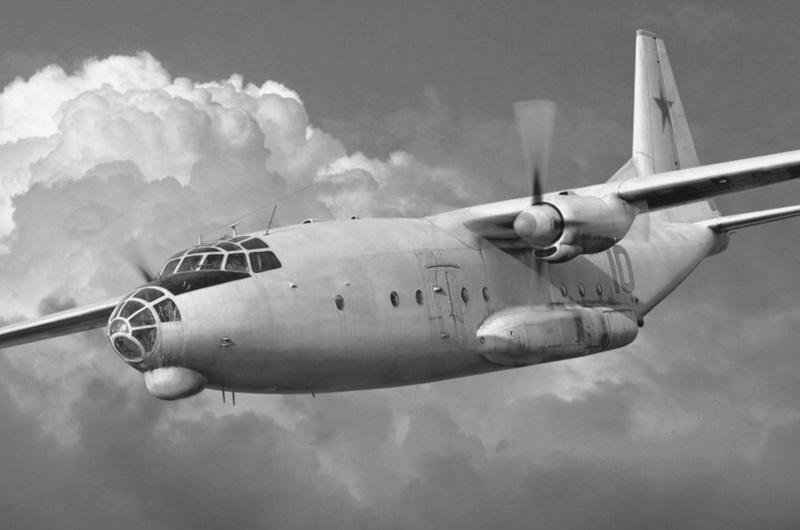
NATO assigned the type the reporting name "Camp". Apparently crews gave it the nickname "Keet (Whale)" -- though it was arguably elegant as cargolifters go, with clean lines and a long, narrow-chord wing featuring a mildly swept leading edge and straight trailing edge. The tailfin had a prominent forward fillet. The An-8 did have the typical idiosyncrasies of Soviet transports in the form of nose glazing for the navigator, with a chin blister for navigation radar underneath, and a high-perched manned tail turret, with twin AM-23 23-millimeter cannon. There was a bombsight under the nose glazing for targeting parachute drops. The An-8 carried a crew of six and up to 60 fully-equipped troops, or 40 paratroopers.
___________________________________________________________________
ANTONOV AN-8 "CAMP":
___________________________________________________________________
wingspan:
37.0 meters (121 feet 5 inches)
wing area:
117.2 sq_meters (1,262 sq_feet)
length:
30.74 meters (100 feet 10 inches)
height:
9.7 meters (31 feet 10 inches)
empty weight:
21,250 kilograms (46,845 pounds)
MTO weight:
38,000 kilograms (83,775 pounds)
max cruise speed:
600 KPH (375 MPH / 325 KT)
service ceiling:
9,600 meters (31,500 feet)
range (max load):
2,280 kilometers (1,415 MI / 1,230 NMI)
range (max fuel):
3,500 kilometers (2,175 MI / 1,890 NMI)
___________________________________________________________________
Given the fact that the An-8 was clearly underpowered, it isn't too surprising that it appears it wasn't all that satisfactory in practice, since only 150 production machines were built to end of manufacture in 1961, and it remains an obscure aircraft. All went into service with the VTA -- the air transport arm of the VVS, the Voyenno Vozdushniye Sily (Red Air Force) -- though many would be later passed on to other Soviet users. It doesn't appear that any were exported. An-8s lingered in service into the 1990s; most had the tail turret faired over in service.
BACK_TO_TOP* Even before the first flight of the An-8, the Antonov organization was considering a commercial airliner derivative. Studies soon evolved into a concept for a larger four-engine machine of generally new design, which would be built in two series -- one as an airliner and the other as a cargolifter to replace the An-8. Formal development work on the new concept was authorized at the end of 1955. A prototype of the airliner variant, the "An-10 Ukraine", performed its initial flight on 7 March 1957, again with Vernikov at the controls; a ground-test prototype was also built. Initial production machines were rolled out before the end of 1957 from State Factory Number 64 in Voronezh. The type entered operational service with Aeroflot, the Soviet state airline, in 1959. NATO assigned the type the reporting name "Cat".
The An-10 had only a broad resemblance to the An-8. It retained the same high-wing general layout, with the nose glazing and chin radar blister, but along with the four engines and greater size -- almost half again the empty weight of the An-8 -- the An-10 had a fuselage of circular cross-section, no tail doors, and no tail turret. At the outset, it had a tail surface arrangement like that of the An-8, except for the addition of a single fixed ventral fin.
The initial prototype was fitted with Kuznetsov NK-4 turboprops, providing 2,985 kW (4,000 EHP) each, but production machines used the Ivchenko AI-20 turboprops with the same power ratings -- the NK-4s being used only because development of the preferred AI-20 had been delayed. The engines drove four-bladed reversible propellers. The landing gear arrangement was similar to that of the An-8, with twin-wheel nose gear and 2x2 main gear bogies, though the main gear assemblies retracted inwards instead of backwards.
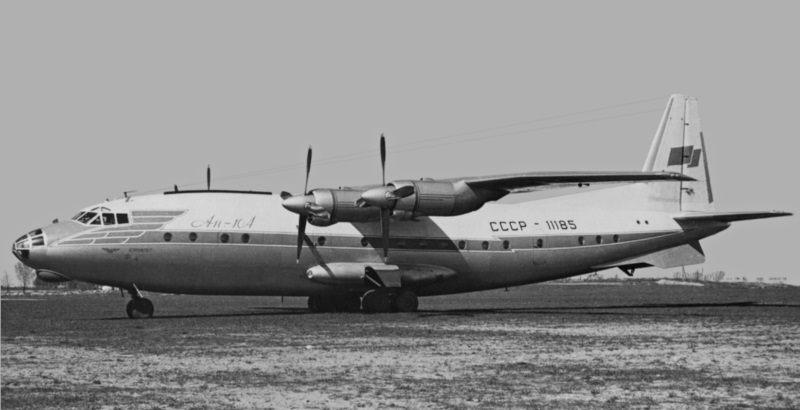
The wings had drooping outer panels. Trials demonstrated that the An-10 had poor yaw stability; a taller tailfin was added to fix the problem, and when it didn't, endplates were attached to the tips of the tailplane. Ultimately, twin ventral fins were fitted instead of the endplates, though sources are unclear on how well that worked.
Passenger capacity was 85, with a passenger door in the left rear of the fuselage, a second passenger / flight crew door under the left wing root, and a large cargo door in the right rear. The aircraft could be easily reconfigured for cargo hauling -- with a load of 15 tonnes (33,070 pounds) of cargo -- or to a "combi" configuration with freight forward and passengers to the rear -- with a load of 9,080 kilograms (20,020 pounds) of cargo and 52 passengers.
___________________________________________________________________
ANTONOV AN-10 "CAT":
___________________________________________________________________
wingspan:
38.0 meters (124 feet 8 inches)
wing area:
119.5 sq_meters (1,286 sq_feet)
length:
34.0 meters (111 feet 6 inches)
height:
9.83 meters (30 feet 3 inches)
empty weight:
29,800 kilograms (65,900 pounds)
MTO weight:
55,100 kilograms (121,475 pounds)
max cruise speed:
680 KPH (425 MPH / 370 KT)
service ceiling:
12,000 meters (39,400 feet)
range (max load):
1,200 kilometers (745 MI / 650 NMI)
range (max fuel):
4,075 kilometers (2,530 MI / 2,200 NMI)
___________________________________________________________________
* The initial An-10 was followed in production in late 1959 by the "An-10A", with some fixes and seating options for either 89 or 100 passengers, later increased to 112, with trials for 132 seats. There was no fuselage stretch -- it was just a question of packing in more seats. Later An-10A production featured improved AI-20K engines. There were several other variants:
The An-10 enjoyed good operating costs, short-field capability, and payload, with Aeroflot making intensive use of the machine, but only 104 were built, including both prototypes, and no An-10s were exported. Its career with Aeroflot came to an abrupt end in May 1972, when an An-10A crashed after take-off, killing all aboard. The An-10 was permanently grounded for regular passenger service in 1973, but many continued to fly in military or industrial service until they outlived their airframe lives.
BACK_TO_TOP* Although the An-10 took priority, work proceeded on its cargolifter sibling, which was given the designation of "An-12". Initial flight of the first of two An-12 prototypes was on 16 December 1957, once again with Vernikov at the controls. These two machines were effectively production prototypes, since the basic airframe was so much like that of the An-10 -- the two machines were all but identical from the wing forward. Indeed, at least early on, it was in principle possible to convert one to the other just by changing the rear section; it was only actually done once as a stunt, and as the aircraft configurations were gradually tweaked in production, it became less and less practical. The compatibility imposed some weight penalties on the An-12, but such issues were regarded as tolerable.
Of course, being a military cargolifter the An-12 had a stronger resemblance to the An-8. The new rear fuselage featured a manned tail turret mounting twin Afansayev-Makarov AM-23 23-millimeter cannon with 350 rounds per gun, as well as a ranging radar system. The tail assembly was very much like that of the An-10, but the tailfin featured a much larger forward fin fillet -- there were no ventral fins. There were rear loading doors, with a top door that hinged up and twin lower doors that opened inward to lie flush with the sides. If vehicles were carried, a two-piece loading ramp was stowed in the cargo bay and then muscled into place manually, with a telescoping leg being extended to prevent the aircraft from tipping back its tail. The ramp scheme made unloading vehicles and the like in a hurry troublesome, but it did allow vehicles to be backed up to the back of the cargo hold for loading. The doors could be opened in flight for cargo paradrops.
Production began at State Factory Number 39 in Irkutsk in 1957, with the An-12 reaching initial operational capability with the VTA in 1959. When NATO became aware of the type, it was initially assigned the reporting name of "Cat-B" on the basis of its commonality with the An-10 -- but on reconsideration it was given the reporting name "Cub", with the initial production An-12 becoming the "Cub-A" when later An-12 variants were introduced. Production at Irkutsk was phased out in 1960, being taken up in that year by production at State Factory Number 64 in Voronezh, which had produced the An-10 -- one of the reasons An-10 production was curtailed was because of focus on An-12 production -- and State Factory Number 84 in Tashkent, which had produced the An-8.
* The initial production An-12 provides a baseline for description of the family. The An-12 was, like the An-10, powered by four Ivchenko AI-20A turboprops providing 2,985 kW (4,000 EHP) each, driving four-bladed reversible propellers. The engines were electrically started. There were 22 bag fuel tanks in the inner wings and the center wing torsion box; the fuel tanks in the inner wings were self-sealing, while those in the torsion box were not. Construction was mostly of aircraft aluminum alloy, though some magnesium alloy was used as well.
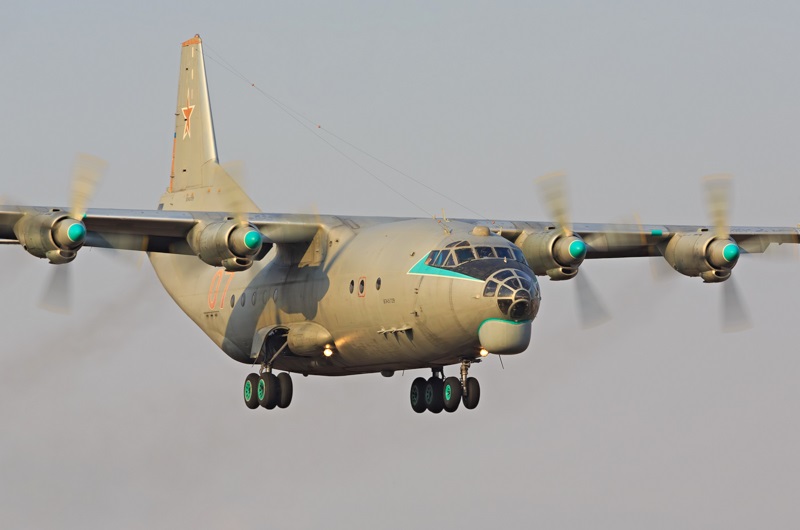
The wings featured drooping outer panels. Each inner wing had three-section double slotted flaps and dual spoilers, while each outer wing had two-section ailerons. The wing leading edge and engine air intakes were de-iced by engine bleed air, while the tail surfaces, props, and windscreens were electrically de-iced. The An-12 had the same landing gear arrangement as the An-10, with twin-wheel nose gear retracting forward and four-wheel 2x2 main gear bogies, retracting into fairings alongside the fuselage. The nose gear was steerable, and the main gear had antiskid brakes; low-pressure tires were fitted for rough field operation.
The An-12 featured a crew of six, including pilot and copilot; flight engineer; radio / radar operator; navigator; and (if judged necessary) a rear turret gunner. The crew cabin was pressurized. The navigator sat in the glazed nose; as with the An-8, a bombsight was fitted, mostly for directing parachute drops. Cockpit armor was fitted to protect the aircrew. There were dorsal and ventral hatches for getting out of the aircraft in an emergency, and a cockpit window could be opened on each side for use as an emergency exit.
There was a compartment directly behind the aircrew compartment for accommodating loading crews, or the crews of vehicles being carried. Both these sections were pressurized. The tail gunner's compartment was pressurized as well; it was accessed from the cargo hold and featured a ventral escape hatch, as well as armor and armor glass.
___________________________________________________________________
ANTONOV AN-12 "CUB":
___________________________________________________________________
wingspan:
38.0 meters (124 feet 8 inches)
wing area:
121.7 sq_meters (1,310 sq_feet)
length:
33.1 meters (108 feet 7 inches)
height:
10.53 meters (34 feet 6 inches)
empty weight:
28,000 kilograms (61,730 pounds)
normal weight:
55,100 kilograms (121,475 pounds)
MTO weight:
61,000 kilograms (134,480 pounds)
max unloaded speed:
775 KPH (480 MPH / 420 KT)
max cruise speed:
670 KPH (415 MPH / 360 KT)
service ceiling:
10,200 meters (33,465 feet)
take-off run (max load):
700 meters (2,300 feet)
range (max load):
3,600 kilometers (2,235 MI / 1,940 NMI)
range (max fuel):
5,700 kilometers (3,540 MI / 3,075 NMI)
___________________________________________________________________
The cargo hold wasn't pressurized, but it did have a space heater. Despite the fact that the fuselage had a circular cross-section, the cargo bay was rectangular, with a maximum width of 3.5 meters (11 feet 6 inches) and a maximum height of 2.6 meters (8 feet 6 inches). There was an electric traveling crane on a gantry running the length of the cargo bay, and twin winches at the front of the cargo bay to pull in vehicles and other payloads. The floor featured tie-down points for securing cargoes, as well as fittings for up to 60 stretchers.
There were permanently-mounted fold-up seats running along each side of the cargo bay for up to 58 paratroopers. Seats could also be installed on the cargo bay floor, providing seating for a total of up to 96 troops. The lack of pressurization limited range when passengers were carried in the cargo bay, since the aircraft had to cruise at lower altitudes where flight was less efficient. There was an entry door plus two emergency exits on the left side of the cargo bay, and one emergency exit on the right side -- as well as a dorsal hatch to be used in case of ditching at sea. There was a luggage compartment under the cargo bay floor, accessible from external and internal hatches, for carrying crew kit or other gear.
Maximum cargo capacity was 20 tonnes (22 tons), allowing the Cub to carry light and medium armored vehicles, artillery pieces, trucks or other wheeled vehicles, and heavy cargoes. Incidentally, the An-12 could also carry small flare bombs in racks under the rear fuselage, and in the main landing gear fairings; in principle, it could carry and disperse naval mines, though there is little evidence it was ever used in that role, and there were trials in which an An-12 was used as a bomber -- its accuracy in that role was poor, but it appears that it was actually used as a bomber on rare occasions by export users lacking better tools for the job.
There was an RBP-2 (NATO reporting name "Toad Stool") navigation radar in a radome under the nose, and the aircraft also had a PDSP-2S Proton-M radio navigation system, along with standard avionics such as radios, radio compass, and "identification friend or foe (IFF)" transceiver. Vertical cameras could be installed, mostly for recording the accuracy of parachute drops.
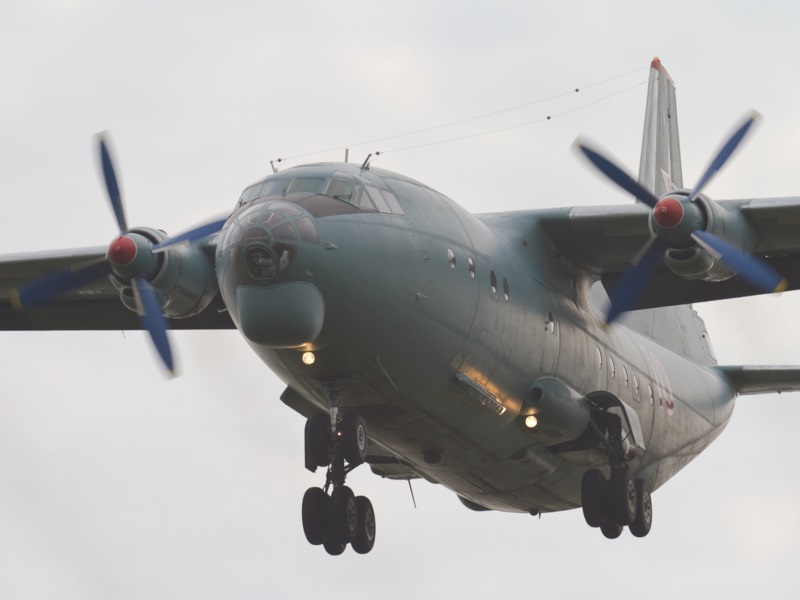
* The An-12 was in many ways comparable to the contemporary US Lockheed C-130 cargolifter, though the An-12 would not remain in production for nearly as long, nor be built in the same numbers. The C-130 was a larger aircraft with greater load volume, but the two machines had comparable load and range. The An-12 was a very capable machine and, after initial bugs were worked out, a good example of rugged and reliable Soviet design.
BACK_TO_TOP* From 1961, An-12 production moved to the "An-12A", the primary improvement being fit of uprated AI-20K engines providing 3,170 kW (4,250 EHP) each. It also featured four more fuel tanks in the wings, for a total of 26 tanks, plus generally updated electronics and some other minor improvements.
The "An-12B" followed the An-12A in 1962. The An-12B featured AI-20M engines, with the same power ratings as the AI-20K but with greater reliability. A TG-16 auxiliary power unit (APU) was installed in the rear of the left main landing gear fairing; fuel tanks were fitted in the outer wings; and there were various minor improvements in kit, such as more powerful cargo winches.
The range of the An-12 was seen as inadequate from the outset, with an experimental "An-12UD" conversion with fuel tanks in the cargo bay flown in 1960. It didn't go into production as such, but from 1963, variants were introduced that featured additional fuel tanks under the cargo bay floor. An An-12 with the underfloor tanks was an "An-12P", while an An-12A with the underfloor tanks was an "An-12AP". Since the An-12A and An-12B were supposedly out of production by 1963, the An-12P and An-12AP appear to have been retrofits of existing machines. However, the An-12B fitted with the underfloor tanks, known as the "An-12BP", was a new production variant, also featuring new avionics. Later production An-12BP machines had a wider rear cargo door to ease loading, and fewer cargo hold windows.
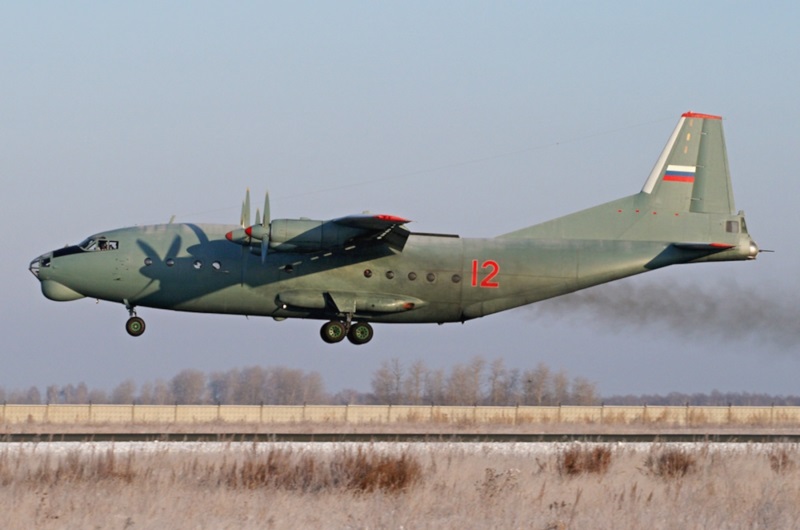
The An-12BP was followed in 1966 by the "An-12BK", which retained the AI-20M engines but added extensive improved kit such as a new TG-16M APU, improved cargo-handling gear, and modernized avionics -- mostly notably much more powerful Initsiava (NATO Short Horn) radar with doubled range, fitted in a much bigger chin radome. At least one An-12BK was converted into a military VIP transport, with a pressurized passenger capsule in the cargo hold.
From 1964, a dedicated civil version of the An-12B was produced, with the tail turret faired over, military avionics eliminated, the parachuting kit removed, and the rear flare bomb compartment turned into a battery compartment; a civil version of the An-12BP was also later produced. Western sources -- often confused about the details of Soviet equipment, thanks to Soviet security -- reported the designations of "An-12V" or "An-12MGA". No such designations exist in Soviet records, and it appears that these civil machines had the same designations as their military equivalents.
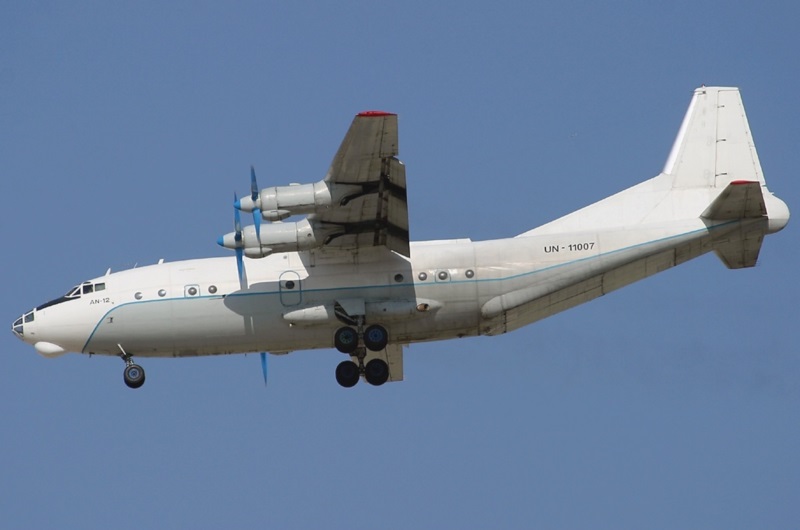
In the course of the An-12's career, many machines were gradually phased out of military service and passed on to civil users such as Aeroflot. The tail turret was faired over, though in some cases the guns were yanked and the windows "boarded up" with sheet metal, or simply painted over. Military avionics and parachuting gear were also pulled. Some sources mention the existence of An-12 variants with designations such as "An-12TA", "An-12TB", "An-12TBP", and "An-12TBK"; one might suspect they were designations for civilianized conversions of the An-12A, An-12B, and so on, but the information on them is very contradictory.
BACK_TO_TOP* Total Soviet production of the An-12 was 1,250 aircraft to end of manufacture in 1972. There was consideration of improved basic variants, most significantly a stretched and heavily redesigned "An-40", but the VTA instead focused on acquisition of the jet-powered Ilyushin Il-76 cargolifter. The An-12 still remained a major component of fleet strength for decades, not merely in the cargolifter role, but also in "special mission" roles -- discussed later.
An-12s flew trooploads during the Soviet occupation of Czechoslovakia in 1968. The An-12 proved an important asset in the Soviet war in Afghanistan in the 1980s. While the Il-76 could carry a much bigger load, it couldn't operate off of short, unimproved airstrips under the "hot & high" conditions encountered in Afghanistan. An-12s suffered a number of losses during the conflict, particularly from shoulder-launched Stinger surface-to-air missiles (SAM) supplied by the US to the Afghan Mujahedin insurgents.
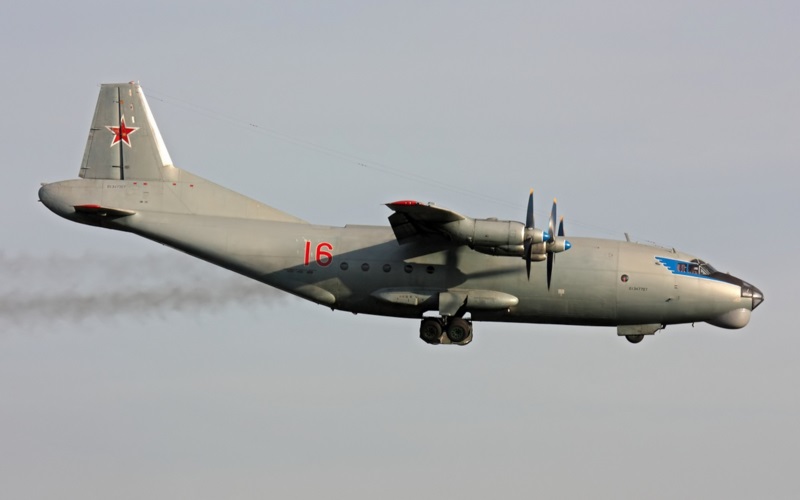
In response to Stinger attacks, An-12s serving in Afghanistan were fitted with a 30-round chaff-flare dispenser on each side of the lower forward fuselage, the dispensers resembling aerodynamic strakes. Incidentally, the Soviets developed chaff-flare rounds for cannon and in principle the tail turret could have been used as a countermeasures system, but for whatever reason the An-12 didn't use those rounds. It was likely nice to have a pair of eyes sitting in the rear gun position just to watch out for trouble.
Inert gas fuel tank pressurization was retrofitted to An-12s as well to reduce their vulnerability to fire, while An-12 pilots adopted tight spiral descents into and ascents out of Afghan airfields to reduce opportunities for being fired upon; flight control surfaces were reinforced to deal with the added stress imposed by such maneuvers. While the An-12s brought weapons and supplies into Afghanistan, they didn't go home empty, performing the unpleasant duty of hauling coffins of Soviet soldiers killed in the war zone -- a role referred to for some obscure reason as "Chorniy Tyulpan (Black Tulip)".
Of course, Aeroflot and other Soviet civil organizations made good use of the An-12 as well, particularly as older machines were phased out of VTA service into civil hands. Following the collapse of the USSR, the An-12 remained in service with the Russian Air Force -- being used in the conflict in Chechnya in the 1990s -- and with most of the Soviet successor states. The An-12 has continued to fly in the modern Russia in good numbers, being a sturdy machine with plenty of airframe life.
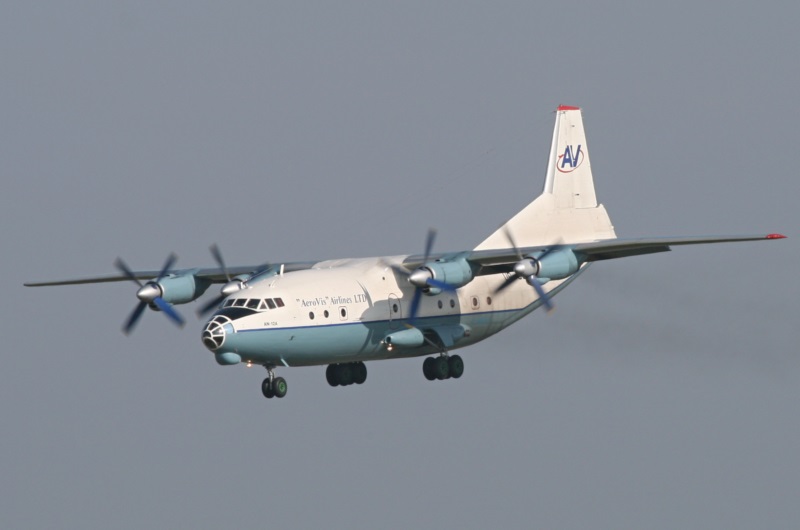
* Important foreign users of the An-12 included:
* Somewhat surprisingly, most of the Warsaw Pact nations didn't operate the An-12 until after the fall of the USSR. Poland and Czechoslovakia were exceptions, each obtaining two machines. Bulgaria now operates a fairly large fleet of An-12s, obtained second-hand from a wide range of sources. For whatever reason, Bulgarian machines usually have the chin radome removed. The pattern of other users is complicated, particularly since there has been a lot of leasing and "horse trading" of An-12s, with aircraft changing hands on a regular basis. Disregarding users mentioned above:
An-12s were also leased or temporarily owned by operators from Canada, Fiji, France, Greece, Malta, the Maldives, Portugal, Singapore, and the UK. White-painted An-12s from various sources have been important players in various international relief operations under the control of the United Nations (UN) World Food Program, the UN High Commissioner for Refugees, and the International Red Cross.
BACK_TO_TOP* Along with the main production variants, small numbers of An-12s were built or modified to special configurations:
There were a number of one-off experimental conversions of An-12s -- for example a ballistic missile transporter and an airborne command post -- that didn't go into production. The An-12 was widely used for trials, testing out various avionics subsystems and engines; a few were fitted with water sprayer systems for inflight icing tests, and another was used for parachute test drops of the early Soviet Vostok space capsule.
One An-12B was given extensive modifications to test infrared sensors and other kit, this aircraft featuring a "pointy nose", a canoe fairing topside behind the cockpit, and the tail turret extended by a plug to also test fire-control radars. This machine was referred to as the "Koobrik" for some reason, the name meaning crew quarters on a ship. One particularly interesting trials machine was an ejection-seat testbed, with the seat fired from an extended tail fairing that could be rotated upside-down, and with cameras on small pods under the wingtips to observe the test firings. This was referred to as the "An-12M LL", where "LL" stood for "Letayushchaya Laboritoriya (Flying Laboratory)", a common designation for Soviet trials aircraft.
BACK_TO_TOP* The Chinese built copies of the An-12 as the "Y-8". Several An-12s were obtained by China from the USSR in the early 1960s, but cooperative work on license construction of the type fell victim to political frictions between the two nations, with the Soviets withdrawing technical assistance for the effort. The Chinese Xian Aircraft organization finally managed to get a prototype into the air on 25 December 1974. Unlicensed production was assigned to the Shaanxi Aircraft organization, with the first production machine performing its initial flight on 29 December 1975. The Y-8 entered service in 1981.
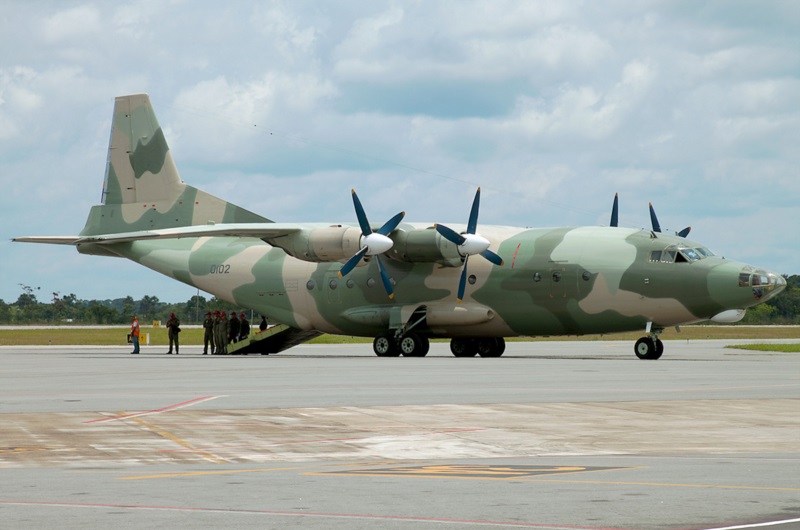
The Y-8 was powered by WJ-6 turboprops, which were Chinese-built AI-20Ks. All but early Chinese production had a distinctive lengthened nose -- either to provide more space for the navigator or to leverage off assemblies from the H-6 jet bomber, a Chinese-built version of the Tupolev Tu-16 "Badger". The tail turret of the Y-8 was almost always faired over after initial production. A number of variants were produced:
The Chinese found the Y-8 particularly useful for special missions, generating a wide range of variants, generally in small numbers:
Late-production Y-8 variants tended to have six-bladed composite propellers, which may be retrofitted to older production as well. Y-8GX-6 AKA Y8Q / KQ-200 ASW platform:
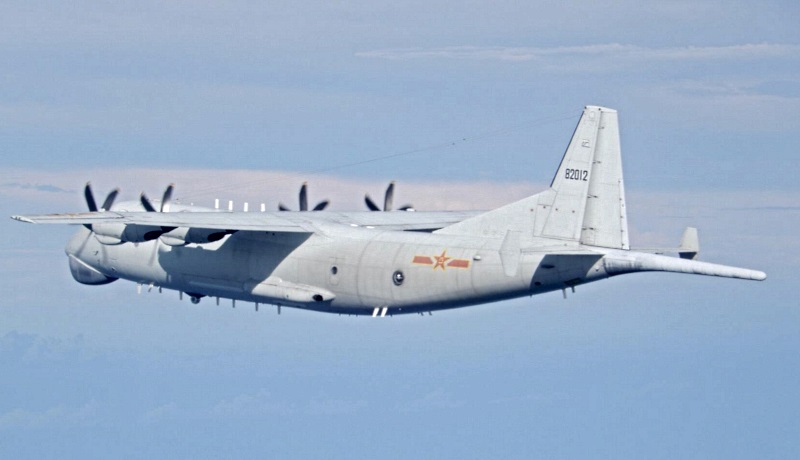
A "Y-9" with a stretched fuselage, updated engines, plus more range and payload was introduced to service in 2012. The Y-9 is powered by Wojiang FQJ-6C turboprops, driving six-blade composite propellers. It can carry 25 tonnes (27.5 tons) of cargo, or 132 paratroopers, or 106 troops, or 106 stretchers plus attendants. Known Y-9 variants include:
* During the mid-1980s, work was initiated at the Antonov design bureau for an advanced four-engine transport to replace the venerable An-12 in Soviet service. In 1992, after the fall of the Soviet Union, a model was shown of the design, which was designated the "An-70".
The An-70 was a swept-wing, high-wing machine, powered by four Progress D-27 propfan engines. Each engine had a take-off power of 10,300 kW (14,000 SHP) and drives a swept contra-rotating propeller. It carried a crew of two to five, and featured a full glass cockpit along with fly-by-wire controls. Its cargo compartment had a length of 19.1 meters, a width of 4 meters, and a volume of 425 cubic meters. It could carry a maximum payload of 47 tonnes, or 110 fully-equipped paratroopers, or 300 soldiers if a second deck was installed.
___________________________________________________________________
ANTONOV AN-70:
___________________________________________________________________
wingspan:
44.06 meters (144 feet 6 inches)
length:
40.73 meters (133 feet 7 inches)
height:
16.38 meters (53 feet 9 inches)
empty weight:
73,000 kilograms (161,000 pounds)
MTO weight:
135,000 kilograms (297,675 pounds)
cruise speed:
800 KPH (500 MPH / 430 KT)
cruise altitude:
12,000 meters (39,350 feet)
take-off run (max load):
1,800 meters (5,900 feet)
take-off run (typical):
900 meters (2,950 feet)
range (max load):
1,350 kilometers (840 MI / 730 NMI)
range (medium load):
5,000 kilometers (3,105 MI / 2,700 NMI)
___________________________________________________________________
The initial An-70 prototype was rolled out from the factory on 20 January 1994, with initial flight on 16 December 1994. The prototype was lost on its fourth flight in February 1995 when it collided with its An-72 chaseplane, killing all seven crew on board. Construction of a second prototype was seriously delayed due to the extreme economic difficulties of the former Soviet states. The Antonov organization was now a Ukrainian company and many of the subcontractors were Russian, adding political complications to the economic problems.
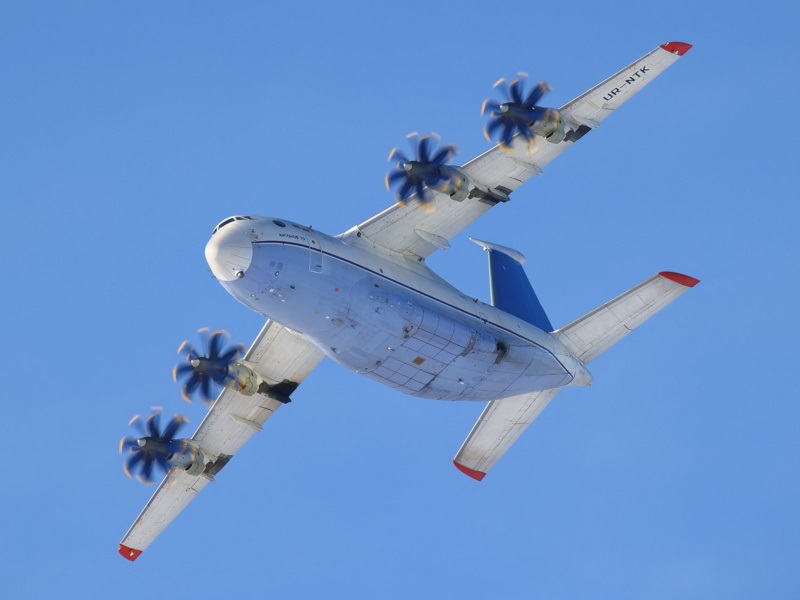
The second prototype was rolled out on 24 December 1996 at a ceremony, with Ukrainian President Leonid Kuchma in attendance. Its initial flight was on 24 April 1997, with Russian Air Force pilots Alexander Galuneko and Anatoly Andronov at the controls, leading to a public debut at the Moscow Air Show in August 1997.
In October 1997, German Defense Minister Volker Roeche opened the door for the An-70 to become a candidate for a new German military cargolifter, as an alternative to the multinational Airbus A400M proposal. In response, a group was formed between Antonov and several Western partners named the "Medium Transport Aircraft Consortium" to offer a moderately Westernized "An-7X" transport for the competition. However, although the An-70 received favorable reviews during its evaluation, politics helped swing the balance to the A400M, and in the spring of 2000 the Germans decided to go with the Airbus offering.
Things seemed more hopeful for the An-70 closer to home, with the Russian Federation committing to the purchase of 164 An-70s in December 1999. In October 2000, the Ukrainian government committed to the purchase of 65 An-70s. The Antonov organization has also pitched the An-70 to China, discussing a coproduction deal with the Chinese AVIC II group.
The sole surviving An-70 prototype performed an emergency wheels-up landing on 27 January 2001. All 33 on board the aircraft survived, though four were injured and the aircraft was badly damaged. It was repaired for certification tests, but the program never seemed to revive, with the Russians pulling out in 2006 -- the stated rationale being that the An-70 had become too expensive, and the improved Ilyushin Il-76MF cargolifter was a better buy.
In 2009, the Russians decided to provide backing for the program after all. A production machine was handed over to Ukrainian forces in early 2015, but the country was in a state of chaos due to internal unrest, with rebels being aided by Russia. The Russians yanked financial support for the An-70 again in 2014, following the Russian seizure of Crimea. That was the effective end of the program.
BACK_TO_TOP* The following list gives primary An-12 production variants:
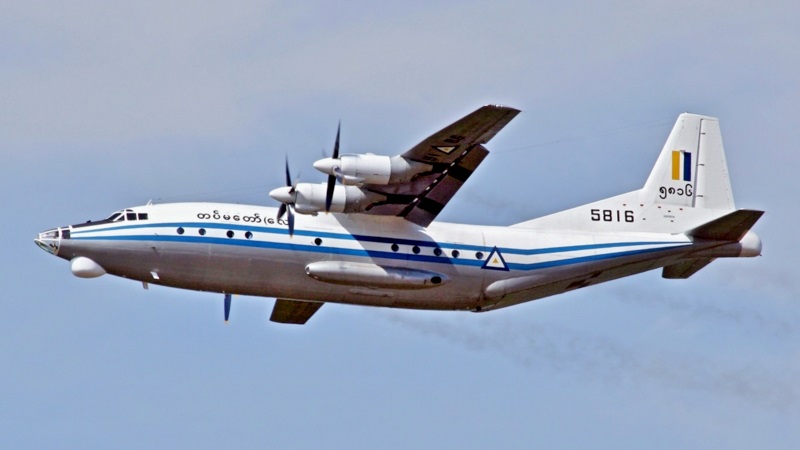
* Sources include:
* Illustrations credits:
* Revision history:
v1.0.0 / 01 jun 10 v1.0.1 / 01 may 12 / Review & polish. v1.0.2 / 01 jul 12 / Modifications as per Sergei Tsvetkov. v1.1.0 / 01 jun 14 / Y-8 special mission variants. v1.1.1 / 01 may 16 / Review & polish. v1.1.2 / 01 jun 18 / Review & polish. v1.2.0 / 01 sep 22 / Illustrations update, more on Y-8 series. v1.2.1 / 01 jul 24 / Review & polish.BACK_TO_TOP
